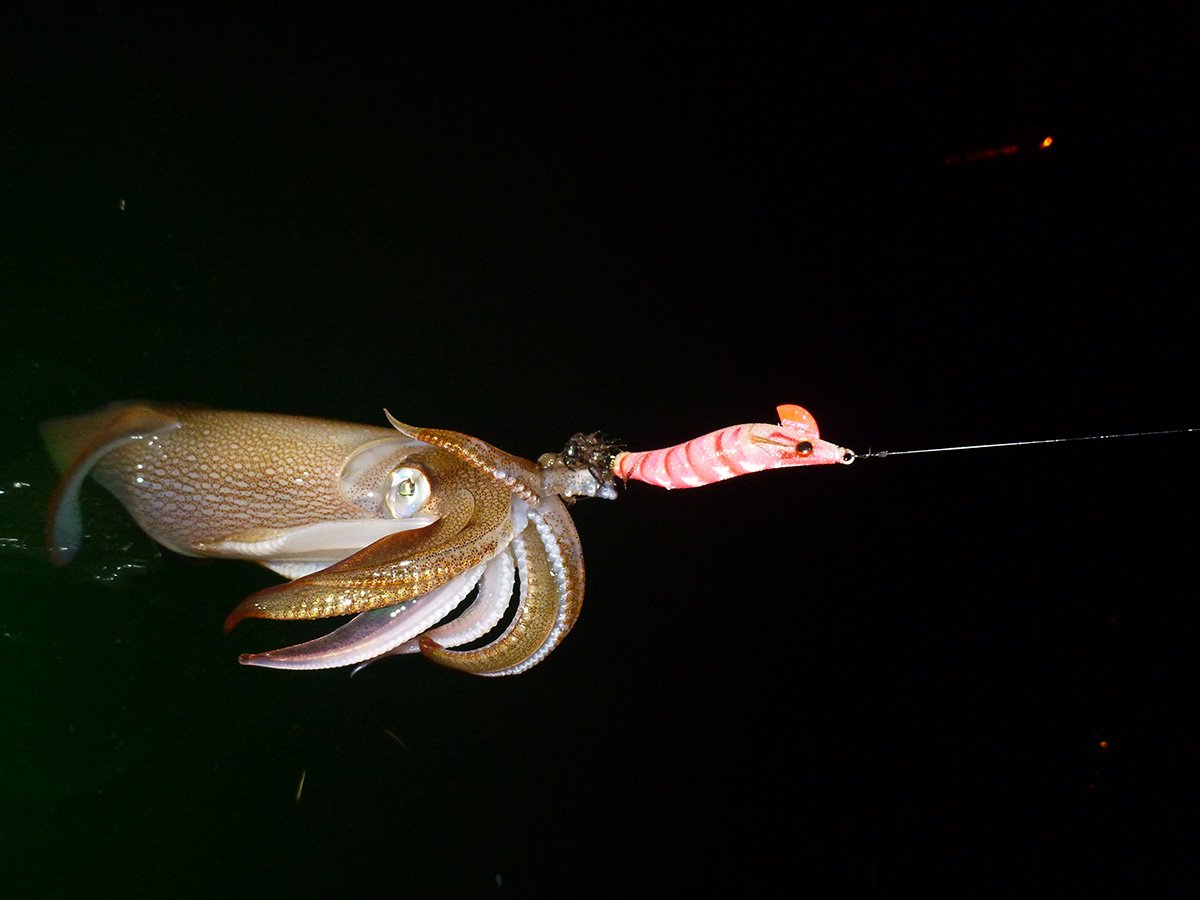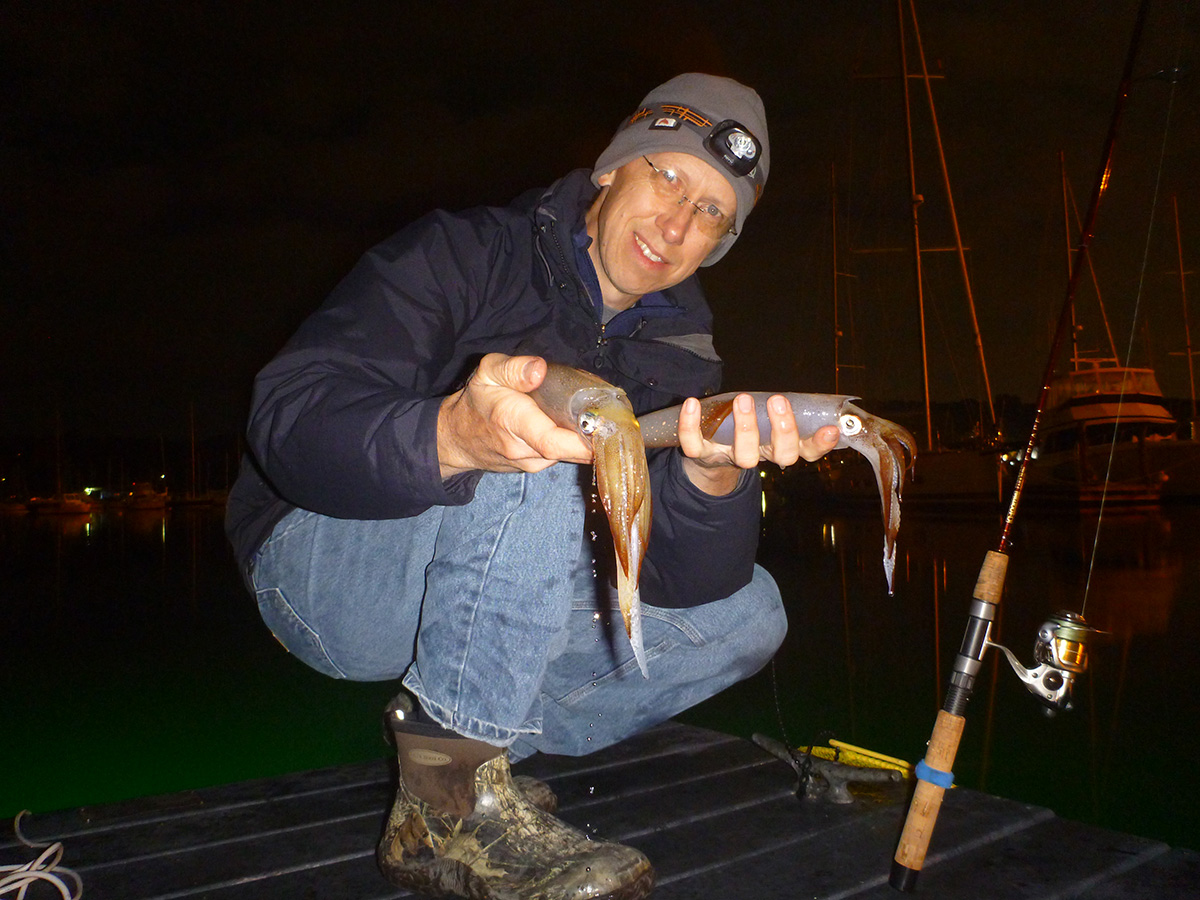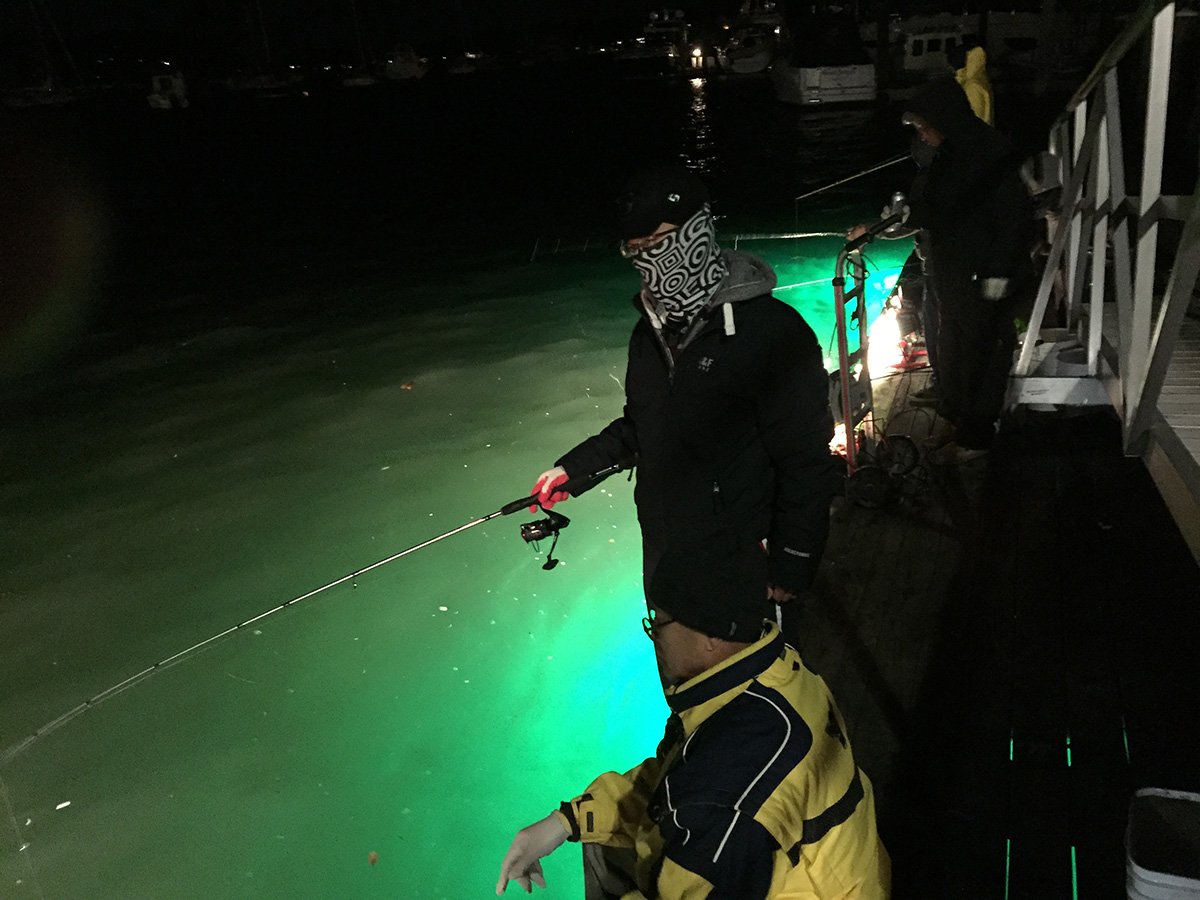
Multitudes of saltwater anglers in the Northeast look forward to the Fall Run each year. All along the coast anglers flock to the shores to chase their favorite gamefish as they gorge on abundant bait, fattening up as they themselves are chased by the approaching winter. There is another fall run however, that dovetails with the winding down of the other, more familiar one: it is the fall squid run. While the number of anglers chasing squid on Long Island has increased in recent years, they still don’t get the same amount of attention as finfish. Still, a passionate corps of anglers devote themselves to catching these tasty, tentacled invertebrates. Over the last few seasons I’ve become a dedicated squid-chaser. For me, they provide a nice bridge between the waning of the local run of stripers and blues in the fall, and the arrival of herring and cod as the year comes to a close.
While squid in the northeast begin to filter inshore as early as May, the fishing doesn’t heat up in many areas until late autumn when the water cools to below the 60-degree mark. This year, squid did not show in Long Island Sound harbors until November, and with the exceptionally mild fall we experienced, we should have them around through most of December. In recent years, the run has carried right into the Christmas holiday.
One very obvious way squidding differs from most other types of angling is the extensive use of lights to attract the quarry. Specifically, lights are used to attract bait such as spearing and grass shrimp, which in turn attract the squid. Anglers who want to try squid fishing for the first time may be put off by believing they must have a light to get started. This is not the case. I’ve caught squid without using a light on many occasions, and many docks already have enough lights installed to attract squid. Additionally, if you choose a dock that is a popular squidding spot, you will usually find plenty of hardcore squid anglers there with lights in the water attracting squid to the general vicinity. That being said, it is a fact that using an underwater light improves your catches, so if you try squidding and take a liking to it, it’s worth springing for a light of your own. There are a number of different brands of submersible LED arrays available. They can be run off a 12v deep cycle battery, and tend to have a very low amperage draw for the amount of light they produce. My 4-inch stick light is made by Hydro Glow. It works wonders for attracting squid. I highly recommend it, though I did have to replace the battery clips soon after purchase. They were not made from marine-grade material, and were poorly attached so that they fell off after three trips. After a quick trip to my local marine store for a pair of new clips I was back in business and haven’t had a problem since. One additional tip is to pick up a cheap hand truck for transporting your battery, as well as other gear, from the car to the dock and back. I picked mine up at the Home Depot for $15 and it has been worth every penny.
Almost any dock in any bay or harbor along the North Shore has the potential to hold squid. Thankfully, local access restrictions are generally relaxed at this time of the year, so the choice of venues is pretty good. I just try and look for a spot where the water depth is at least 4 to 5 feet at low tide. Keep in mind that just because a few docks get most of the attention, it doesn’t mean that other, quieter spots nearby won’t be potentially just as good.
Most nighttime squid fishing involves vertical jigging, so I focus solely on that technique here (See my article on casting for squid in the May 2017 issue of The Fisherman.). Proper rigging and presentation are the two biggest factors determining success or failure in squidding. I’ve seen many different rigs and jigging methods employed. Doing it right can mean the difference between catching a bucket full or coming up empty. Let’s start by going over jig types and rigging.

Most locally available jigs are made by Yo-Zuri. They all work, so choose whichever one speaks to you. Personally, I prefer the small Yo-Zuri aurora mini jigs in orange or pink colors. I’ve heard some squidders scoff at using small jigs on the theory that they catch only small squid. My experience has been that they just catch more squid overall, not necessarily fewer big ones. The castable jigs known in Japan as egi can also be rigged for vertical jigging, although they don’t work quite as well as the jigs that are specifically designed for that purpose. Egi can be distinguished from the vertical-style jigs by their distinctive bent bodies and built-in weight under the throat. For vertical jigging, you want to look for the floating or neutral buoyancy jigs, which have a straight body and little or no weight under the throat. In addition, the lures meant for vertical jigging have a swiveling eye for attaching to your line, while the eye on a castable jig is fixed.
Opinions vary widely on the best way to rig up squid jigs. By far my favorite is a tandem drop-shot rig. The drop-shot is a type of rig commonly used for freshwater bass, which allows precise control over your lure’s action. It’s completely tangle-free, and is easy to tie. Start with a piece of 4- to 8-pound fluorocarbon about 6 feet long. Tie one of your jigs onto the line using a palomar knot, leaving a tag end a little over a foot long, then tie a loop knot on this end for a sinker, so that the jig is about 6 to 10 inches from the bottom. Next, tie on another jig in the same way about 16 to 18 inches above the first. This will leave a very long tag end on the top end of the rig. To finish it off, tie a small barrel swivel to the tag end about 24 inches above the top jig on your rig for attaching to the main line from your reel. The finished rig should be 4 to 5 feet long. For weight I usually opt for a 1/2-ounce dipsy or bank sinker to start off. Adjust your weight for depth and current as needed to keep contact with the bottom, but always use the lightest sinker possible.
As far as rods and reels are concerned, light is the name of the game. Our single species of squid tops out at about a half-pound, and they don’t put up a huge fight. In addition, using the lightest possible outfit will enable you to feel the subtle tap of a squid zapping your jig with its tentacles. Go for a light spinning set-up similar to what you might use for freshwater panfish and bass, or snapper blues in the salt. A 6- to 7-foot light-action rod and matching reel spooled with 10-pound test braid works fine.
Now let’s discuss jigging technique. Every time I go squidding I see all different kinds of jigging styles going on around me. Many are random, and nearly all of them are too rapid and extreme. Seriously, even dead-sticking works better than waving your rod around like you’re being attacked by a swarm of bees. While squid may vary somewhat in their preferences from one night to the next, there is a basic jigging action that works for me nearly every time, and it’s very simple to do. First, drop your rig to the bottom and engage your reel. Next, snap your rig upwards sharply one to three times. Now, s-l-o-w-l-y lower your rod tip until you feel the sinker hit bottom again. Keep your rig stationary for several seconds before repeating the process. Squid usually hit just as the sinker hits bottom, or within a few seconds after. The most important thing to know and remember here is that the squid are initially attracted to the sharp, upward snapping of a jig, but prefer to strike a lure that falls slowly. If you let your rig drop quickly at its own speed on a slack line it will not get as many hits as it will by using a slow, controlled fall. Keep this in mind and you are on your way to catching a bucket-full. I’ve seen this specific action out-catch others by as much as 10-1.
Of course, it may be necessary to modify your jigging technique to suit the conditions where you happen to be fishing. If the bottom is full of snags, then arrest your rig’s fall before it comes to rest. Likewise, if the water is deep and the squid are suspended, adjust your jigging depth accordingly.
If you keep a slight amount of tension on your line at all times you may feel a faint tap as a squid attacks your jig. Occasionally though, you just feel a weight on the end of your line the next time you go to snap up your rig. When you do hook a squid be gentle reeling it in, it may be hooked only by a single leg and can easily tear free if you rush it.
Squid bite on a moving tide, so avoid periods of slack water. Don’t be put off by windy conditions. Squid don’t seem to mind choppy water at all, so just bundle up and head out there. I’ve caught well on nights so windy I almost got seasick from rocking on a floating dock. Persistence definitely pays with squidding; it can be an all-or-nothing affair, with some nights producing spectacular catches and others very little. Even on the good nights most of the action can be concentrated in an intense half-hour of catching double-headers as a school of squid moves through. Predicting exactly when that will happen is the $10,000-question. Unfortunately, the ideal combination of tide, wind, moon phase, etc., varies from location to location. My best advice is to just go whenever you can, and keep a log to help you dial into a pattern that leads to consistent success in your favorite spot or spots.
Squid fishing, at its best, is both fun and peaceful, yet it has the potential to be a high-impact activity, and has been banned in some places for a couple of reasons. First, some anglers employ high-powered construction lights run off generators to attract the squid. This is a poor option, and one I strongly discourage, as the noise, and light pollution is disruptive to the communities adjacent to the docks where squid are pursued, besides it being very unpleasant to any other anglers present. The aforementioned underwater LED lights run on battery power are a much better choice.
Errant ink is the other common problem. This can be addressed by simply taking a little extra care with your catch than you would with a finfish. I either put my squid in a nylon mesh bag hung over the side of the dock to let the ink wash away with the tide, or place them in a bucket on the dock with enough water to keep them covered, and then rinse the ink of them by changing the water several times just before I head home. Either of these options is preferable to letting them squirt ink all over the dock, as it makes a mess that can persist for months.
Squidding is a great way to end the fishing season. Besides being fun to catch, they are delicious to eat in a variety of ways. Plus, they freeze better than any other seafood I can think of. This fall pick up your rod, a few jigs and a thermos of coffee, and head down to your nearest dock to check out the action.




